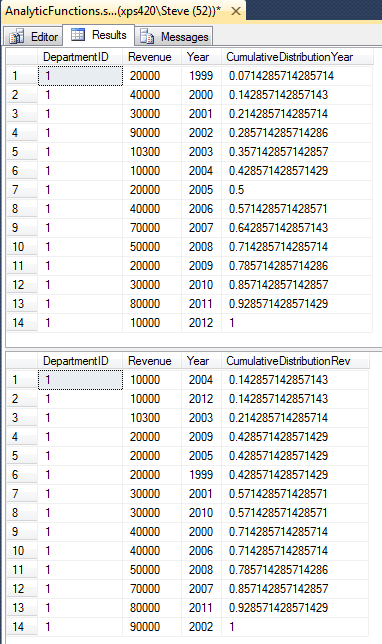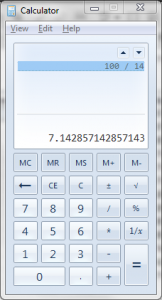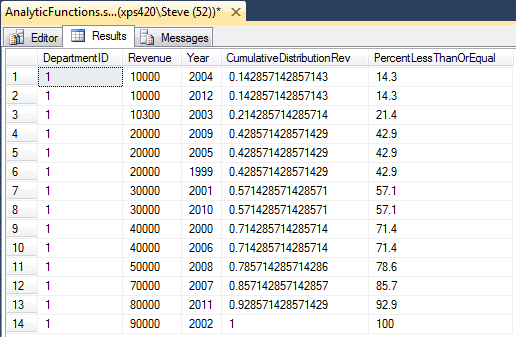Continuing on the TSQL 2012 Analytic Series now on to the CUME_DIST function
SQL Server 2012 introduces another new analytic function. The Cumulative Distribution Function CUME_DIST() refers to the probability that the value of a random variable falls within a specified range.
CUME_DIST is the function that maps values to their percentile rank in a distribution. CUME_DIST function calculates the possibility of another occurrence being of that value or lesser than that among a group of values.
Lets jump into the examples:
-- CUME_DIST for Year select DepartmentID, Revenue, Year, CUME_DIST() OVER (ORDER BY Year) as CumulativeDistributionYear from REVENUE where DepartmentID = 1 order by Year; -- CUME_DIST for Revenue select DepartmentID, Revenue, Year, CUME_DIST() OVER (ORDER BY Revenue) as CumulativeDistributionRev from REVENUE where DepartmentID = 1 order by Revenue;
Which produces the following output:  In the first example with the years being the range looked at from 1999 to 2012, the difference between each cumulative distribution value is 7.1% which with an even calculation could be determined by dividing 100 by the number of values wich produces 7.1% (.0714285….).
In the first example with the years being the range looked at from 1999 to 2012, the difference between each cumulative distribution value is 7.1% which with an even calculation could be determined by dividing 100 by the number of values wich produces 7.1% (.0714285….).  That’s the easy one. You don’t need a TSQL Function to calculate 100 divided by the the number of rows.
That’s the easy one. You don’t need a TSQL Function to calculate 100 divided by the the number of rows.
Now on the the second distribution which calculates the distribution over the revenue numbers. I have added another column to the example above which rounds the Cumulative Distribution to a percentage with one decimal.
</pre> select DepartmentID, Revenue, Year, CUME_DIST() OVER (ORDER BY Revenue) as CumulativeDistributionRev, ROUND(CUME_DIST() OVER (ORDER BY Revenue) * 100, 1) as PercentLessThanOrEqual from REVENUE where DepartmentID = 1 order by Revenue;
From here you can see that the lowest Revenue value of 10,000 was hit in both 2004 and 2012. Keeping in mind the number 7.14% from the previous example you can see that 14.3% is double 7.14% since there are two years with a $10,000 revenue.
This can be useful to determine the percentage of values that are less than or equal to the current value.
That’s it for today. I hope you find CUME_DIST to be useful.
More from Stedman Solutions:

Steve and the team at Stedman Solutions are here for all your SQL Server needs.
Contact us today for your free 30 minute consultation..
We are ready to help!
